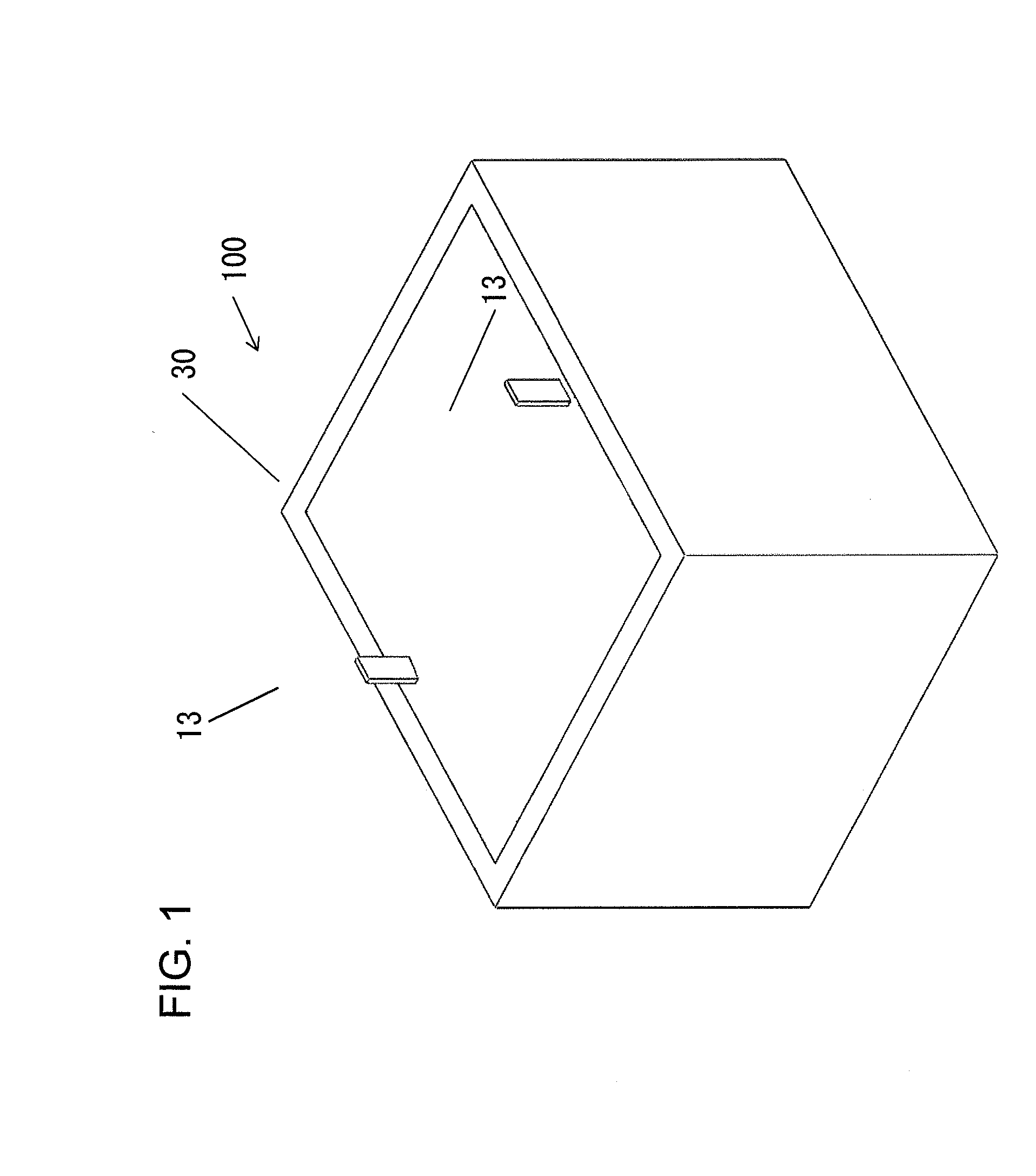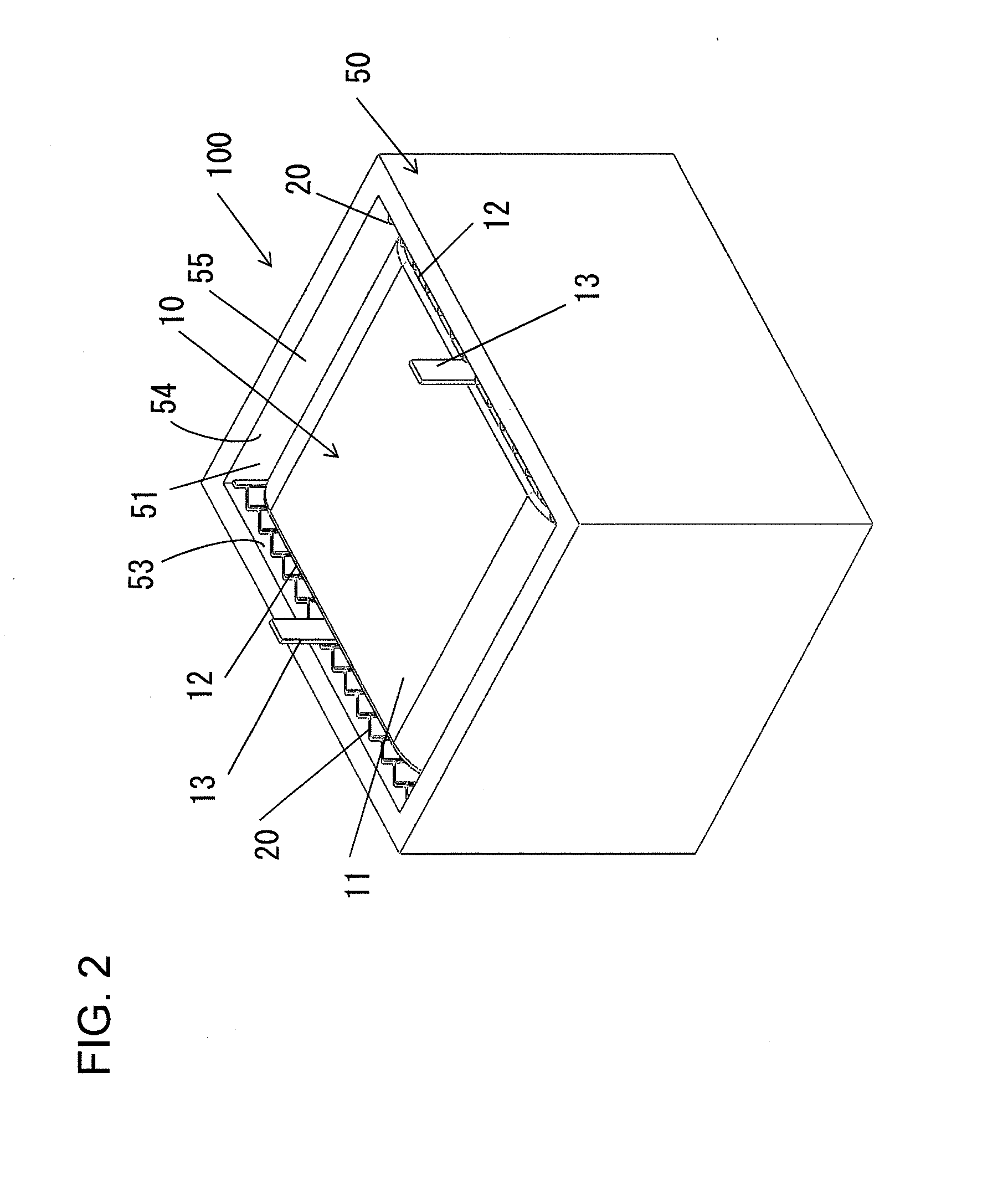Capacitor Device and Electrical Power Conversion Device
a technology of capacitors and capacitor elements, applied in the direction of fixed capacitors, dc-ac conversion without reversal, fixed capacitor details, etc., can solve the problem of insufficient cooling of film capacitor elements, achieve enhanced heat dissipation performance, enhance heat dissipation performance, and high thermal conductivity
- Summary
- Abstract
- Description
- Claims
- Application Information
AI Technical Summary
Benefits of technology
Problems solved by technology
Method used
Image
Examples
embodiment # 1
Embodiment #1
[0030]First embodiments of a capacitor device and of an electrical power conversion device according to the present invention will now be explained with reference to FIGS. 1 through 5. FIG. 1 is an external view of the capacitor device 100 according to the first embodiment, and FIG. 2 is a figure showing the situation in the interior of this capacitor device 100. Moreover, FIG. 3 is an exploded diagram showing the capacitor device 100, and FIGS. 4A and 4B are figures schematically showing cross sections of the capacitor device 100. This capacitor device 100 is a component that is employed, for example, for smoothing DC power produced by an electrical power conversion device that is used in a HEV (hybrid electric vehicle) or an EV (electric vehicle) or the like. A capacitor like this is called a DC-link capacitor.
[0031]The capacitor device 100 comprises a film capacitor element 10, a case 50 made from metal that contains the film capacitor element 10, two resin sheets (i...
embodiment # 2
Embodiment #2
[0048]Referring to FIGS. 6A, 6B and 7, a capacitor device and an electrical power conversion device according to a second embodiment of the present invention will now be explained. In the following explanation, to structural elements that are the same as in the first embodiment, the same reference symbols are appended, and the explanation will principally focus upon the points of difference. Features that are not particularly explained are the same as in the first embodiment. In this embodiment, principally, the aspect that is different from the first embodiment is the feature that, instead of performing positional determination of the film capacitor element 10 by taking advantage of the resilience of the inserts 20, positional determination of the film capacitor element 10 is performed by forming opposing inner walls 57, 57 as inclined, and by also forming the inserts 60 in the shape of tapers or wedges, so that they are engaged with each other.
[0049]FIGS. 6A and 6B ar...
embodiment # 3
Embodiment #3
[0066]Referring to FIGS. 8 through 12, a capacitor device and an electrical power conversion device according to a third embodiment of the present invention will now be explained. In the following explanation, to structural elements that are the same as in the first and second embodiments, the same reference symbols are appended, and the explanation will principally focus upon the points of difference. Features that are not particularly explained are the same as in the first and second embodiments. In this embodiment, principally, the aspect that is different from the first and the second embodiments is the feature that a film capacitor element and a power semiconductor module are received within the same case and function together as an electrical power conversion device.
[0067]The electrical power conversion device of this embodiment is not limited to application in a hybrid automobile (i.e. an HEV); it can also be applied as an electrical power conversion device to be...
PUM
 Login to View More
Login to View More Abstract
Description
Claims
Application Information
 Login to View More
Login to View More - R&D
- Intellectual Property
- Life Sciences
- Materials
- Tech Scout
- Unparalleled Data Quality
- Higher Quality Content
- 60% Fewer Hallucinations
Browse by: Latest US Patents, China's latest patents, Technical Efficacy Thesaurus, Application Domain, Technology Topic, Popular Technical Reports.
© 2025 PatSnap. All rights reserved.Legal|Privacy policy|Modern Slavery Act Transparency Statement|Sitemap|About US| Contact US: help@patsnap.com



